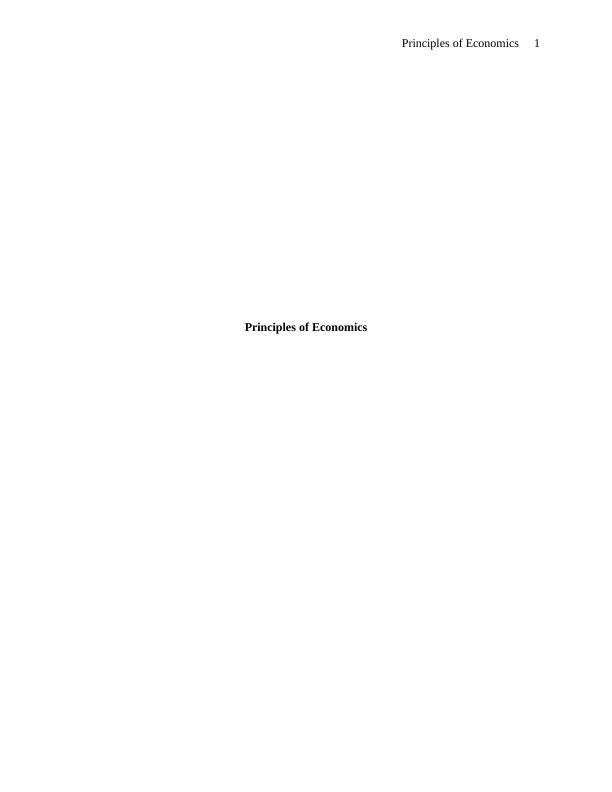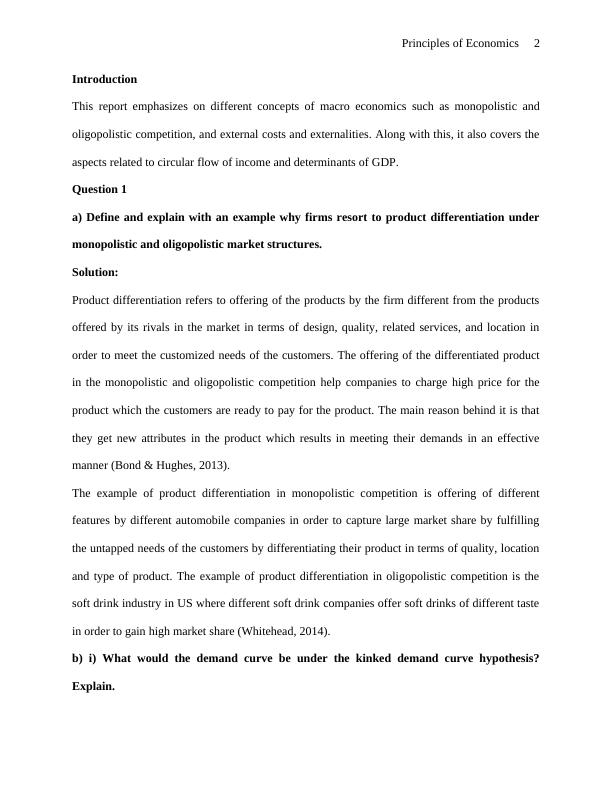Different Concepts of Macro Economics | Report
Added on 2020-02-19
14 Pages3121 Words27 Views
Principles of Economics 1Principles of Economics

Principles of Economics 2IntroductionThis report emphasizes on different concepts of macro economics such as monopolistic andoligopolistic competition, and external costs and externalities. Along with this, it also covers theaspects related to circular flow of income and determinants of GDP. Question 1a) Define and explain with an example why firms resort to product differentiation undermonopolistic and oligopolistic market structures. Solution:Product differentiation refers to offering of the products by the firm different from the productsoffered by its rivals in the market in terms of design, quality, related services, and location inorder to meet the customized needs of the customers. The offering of the differentiated productin the monopolistic and oligopolistic competition help companies to charge high price for theproduct which the customers are ready to pay for the product. The main reason behind it is thatthey get new attributes in the product which results in meeting their demands in an effectivemanner (Bond & Hughes, 2013). The example of product differentiation in monopolistic competition is offering of differentfeatures by different automobile companies in order to capture large market share by fulfillingthe untapped needs of the customers by differentiating their product in terms of quality, locationand type of product. The example of product differentiation in oligopolistic competition is thesoft drink industry in US where different soft drink companies offer soft drinks of different tastein order to gain high market share (Whitehead, 2014).b) i) What would the demand curve be under the kinked demand curve hypothesis?Explain.

Principles of Economics 3Solution:The below demand graph represents the two demand scenarios in which PQ represents thedemand of the quantity at the prices followed by the competitors. Besides this, the AB curvepresents the quantity demanded at the fixed price of the competitors and where there is anintersection occurs that point is represented by O. The equation for PQ demand curve is P+Q=235 and the equation for AB curve is 2P+Q =420. Therefore, the kinked demand curve is AOQthat has a kink at O point. The assumptions taken for this includes that decline in the prices of thequantity demanded are consistent with the decline in the prices done by the competitors. Besidesthis, there is an occurrence of the kink at point O due to the reason that the increase in price ofthe firm is not consistent with the prices of its competitors (Wachtel, 2013).1020304050607080050100150200250300190140025016511520703560200185175200175Fixed PriceFollow PriceMarginal Revenue FixedMR2Follow MCPriceFixed MCQuantityPriceFigure 1 ii) Plot the marginal revenue curve corresponding to the kinked demand curve andexplain.Solution:

Principles of Economics 4The total revenue (TR) has the equation P*Q = (235-Q)*Q. The marginal revenue is representedby change in revenue/change in quantity. The curve get from differentiation is AB marginalcurve which is represented by A’B’ which have a equation MRab = 235 – 2Qin a similar manner, the marginal revenue curve PQ is represented by P’Q’ with a equationMRpq = 210 – Q. The ploting of the marginal revenue curve is depicted in Figure 1 correspondingto kinked curve (Wachtel, 2013).iii) Given that Marginal Cost is $150 at every level of output, copy the table and calculateMarginal Revenue. Determine the profit- maximising level of output and plot it on thegraph. Solution:Competitorsquantitydemanded 1P($) TR1($) TotalRevenueMR1($)MarginalRevenueCompetitorsFollow:QuantityDemanded 2TR2($) TotalRevenueMR2($)MarginalRevenue202004000190357000165301955850180407800155401907600170458550145501859250160509250135601801080015055990012570175122501406010500115The equilibrium of the firm is the profit maximizing level of output at 50 units i.e. the kink pointi.e. O. The main reason behind it is that Marginal revenue is greater than marginal cosrt i.e.$150. Besides this, at the output level more than 50 units i.e. O the marginal revenue is less thanmarginal cost. The profit is maximized at the kink point as the condition MR=MC is not fulfilledwhich is marked by a vertical line Q=50 in figure 1 (Wachtel, 2013).

End of preview
Want to access all the pages? Upload your documents or become a member.
Related Documents
Study Of Principles Of Economicslg...
|15
|2649
|48
Project Report on Monopolisticlg...
|24
|3710
|57
Monopolistic Competition and Oligopoly Marketslg...
|10
|849
|321
Monopoly and Monopolistic Competitive Markets in Australialg...
|11
|2856
|104
BUS5POE Principles of Economics Assignmentlg...
|3
|691
|150
Principles of Economics - Assignmentlg...
|15
|3302
|132
